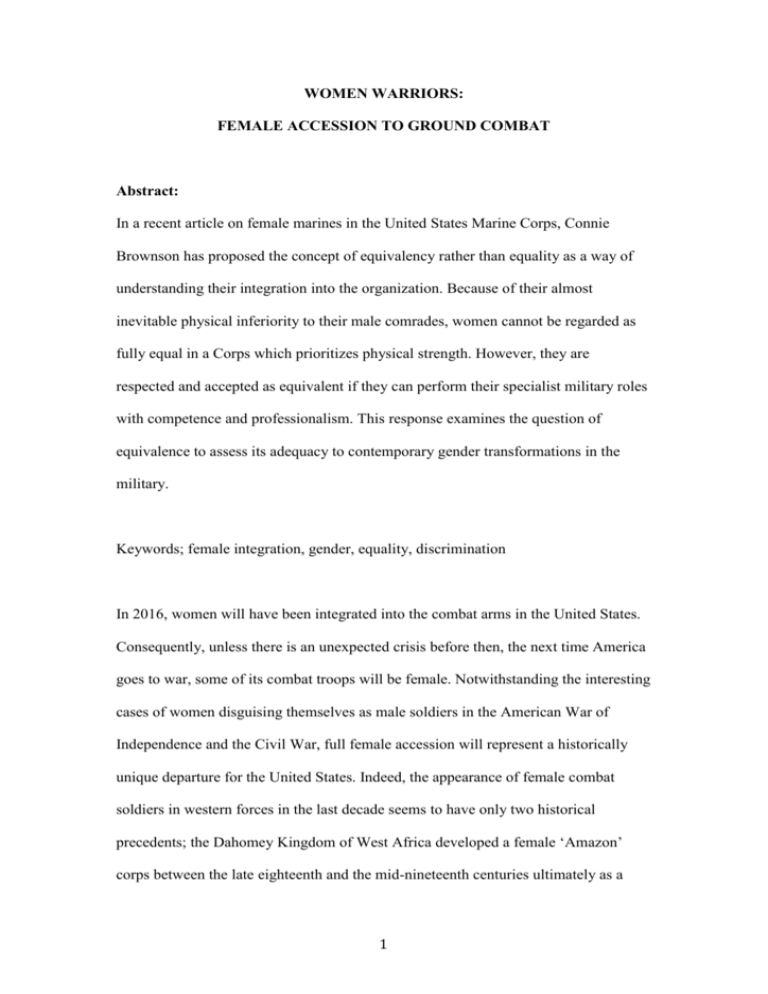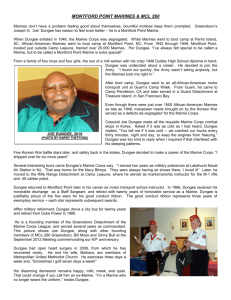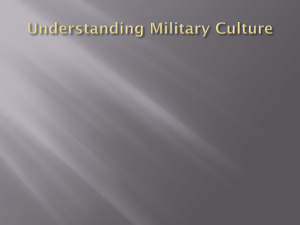
WOMEN WARRIORS:
FEMALE ACCESSION TO GROUND COMBAT
Abstract:
In a recent article on female marines in the United States Marine Corps, Connie
Brownson has proposed the concept of equivalency rather than equality as a way of
understanding their integration into the organization. Because of their almost
inevitable physical inferiority to their male comrades, women cannot be regarded as
fully equal in a Corps which prioritizes physical strength. However, they are
respected and accepted as equivalent if they can perform their specialist military roles
with competence and professionalism. This response examines the question of
equivalence to assess its adequacy to contemporary gender transformations in the
military.
Keywords; female integration, gender, equality, discrimination
In 2016, women will have been integrated into the combat arms in the United States.
Consequently, unless there is an unexpected crisis before then, the next time America
goes to war, some of its combat troops will be female. Notwithstanding the interesting
cases of women disguising themselves as male soldiers in the American War of
Independence and the Civil War, full female accession will represent a historically
unique departure for the United States. Indeed, the appearance of female combat
soldiers in western forces in the last decade seems to have only two historical
precedents; the Dahomey Kingdom of West Africa developed a female ‘Amazon’
corps between the late eighteenth and the mid-nineteenth centuries ultimately as a
1
way of sustaining the slave trade, while the Soviet Army drafted women into the
combat arms between 1942 and 1945.1 The accession of women to combat roles is a
notable departure in world-historical terms which has rightly attracted the attention of
scholars.
Of course, the integration of women into the combat arms in western forces
should be situated in a longer historical context which goes back to the Second World
War (though it might be traced back further to the First World War and even the Civil
War). The accession of women to the combat arms has been incremental but this does
not in anyway deny its institutional and historical significance. On the contrary,
complete female integration into the military represents a profound transformation not
only of the armed forces but gender relations more widely. In this context, Connie
Brownson’s is absolutely correct to identify the question of female accession as
deeply significant to the social sciences today.2 Moreover, her concept of equivalency
provides a useful framework for the discussion of her rich and informative empirical
material about women who have served in the United States Marines Corps, one of
the toughest and most masculine of all military organizations.
The integration of women into the Marines, like most other military
organizations has not always been easy. Brownson is well aware of the intense
opposition which the integration of women has engendered within the armed forces
generally and the Marines, in particular, often manifesting itself in harassment,
bullying and abuse. In this, she confirms the view of many feminist scholars. Feminist
scholars have focused considerable attention on the armed forces, which they see as
one of the principal patriarchal institutions, and have been highly critical of the way in
which women have been exploited by the military. Cynthia Enloe has, of course, been
a pioneering figure in exposing the connections between the armed forces and
2
patriarchy: ‘the military can use this extraordinary status in relation to the state to
define national security. The concept of national security has, in turn, been used to
define social order supposedly necessary to ensure that national security. In this
circular process, national security can come to mean not only the protection of the
state and its citizens from external foes but, perhaps even primarily, the maintenance
of social order’.3 Consequently, in order to preserve patriarchy, women have typically
been excluded from the military. They ‘cannot qualify for the entrance to the inner
sanctum, combat’ because ‘to allow women entrance into the essential core of the
military world would throw into confusion all men’s certainty about their male
identity’.4 Even when they have been integrated, their enrolment has been a ‘cruel
hoax’.5 Female integration has been ferociously resisted through discrimination,
harassment and abuse; the 1991 Tailhook Convention and the 1996 Aberdeen
Training Ground are only two of the most notorious of numerous other incidents.
There is little doubt that female service-personnel have faced very serious
discrimination and often outright harassment in the armed forces.
Connie Brownson recognizes the problem which is clearly evident in the
Marines. Specifically, she identifies institutionalized stereotypes which have been
damaging to women: ‘these problematic but sometimes accurate stereotypes describe
social- “favored”, “slackers” and “whiners”; and sexual as “bitch”, “slut” or “dyke”
categories’.6 For women attempting to integrate into the armed forces, it is the latter
sexual categories, and above all, the slut-bitch binary, which have been particular
obstructive. The schema has been repeatedly emphasized by female service-personnel
and by scholars studying the military.7 Accordingly, it is worth considering the slutbitch schema more closely and to situate its origins historically. There is evidence that
even in the early stages of integration, during the Second World War, when females
3
essentially represented no threat to the masculine military or the men in it, that
women were nevertheless subjected to periodic criticism and denegration. De Groot
records that the behavior of some female service-personnel during the Second World
War was regarded as undesirable: the ‘multitudes of reckless, unstable girls’ in the
British ATS, WAAR and WRNS were accused of spreading venereal disease as a
result of their promiscuity.8 However, with the integration of women into the forces
into the services in the 1970s and the increasing numbers of women serving, this
dismissal of women was accentuated, often taking the form of overt discrimination
and aggressive harassment and abuse. At this point, a new system of cultural
classification emerged at this time to define women either as sluts (sexually available)
or bitches (sexually unavailable), of which lesbians or ‘dykes’ (self-evidently
unavailable) are a subcategory. There have been some ugly manifestations of this
classification system. In the 1980s, the acronym WAF (Women’s Air Force) was
offensively altered to ‘We all fuck’9, while women in the US Navy in the 1990s were
routinely denigrated for their putative promiscuity with the acronym WUBA (Women
Used by All).10 In both cases, women were defined as ‘sluts’. The US were not in any
way unique here. A female British service-person, dismissed following accusations of
her homosexuality in the 1980s, recorded: ‘Men soldiers don’t respect WRACs
[Women’s Royal Auxiliary Corps] at all. It you’re in it, your’re a lesbian or a slut.
And there’s real pressure to sleep with men’.11 The slut-bitch binary seems to have
emerged as an identified historical juncture, therefore, in response to changing
institutional conditions in the armed forces.
Yet, despite manifest advances since that time, there is clear evidence that the
slut-bitch schema endures. Indeed, in her article, Connie Brownson confirms that the
classification is still extent in the armed forces today: her interviewees expressed
4
‘frustration with negative stereotypes and stigma inherited from previous generations’
and applied to ‘poor-performing contemporaries’.12 Implying that these negative
attributions might be deserved, Brownson seems to underestimate the extent to which
these categories are often applied to high-performing and competent female soldiers
due to reasons beyond their own control; sometimes, they are denigrated precisely
because they are highly able and, therefore, threatening to male soldiers. Other
women are defined negatively, despite their actions, if the groups of men with whom
they work decide to classify them in this way often for quite arbitrary reasons relating
to their own personal prejudices or internal social dynamics. The “bitch”, “slut” or
“dyke” categories’ remain central here as a cultural resource for men.
However, despite the endurance of these stereotypes, Brownson seeks to
describe the emergence of new gender categories in the Marine Corps especially as a
result of operations in Iraq and Afghanistan, which have transformed the status of
women. To this end, she proposes the idea of equivalency. She claims that females
cannot genuinely aspire to a ‘bio-social-political ideal of “equality”’ in the Marine
Corps because most women are so much physically weaker than male marines.13
Accordingly, the vast majority of women simply cannot perform the hardest combat
roles especially in the marine infantry. However, while female marines cannot be
considered the physical equal of marines, and especially marine infantry, they can,
nevertheless, be accepted fully as ‘equivalents’. In the military division of labour,
they contribute indispensible, specialist skills; ‘equivalency focuses on the kinship
environment of the US military, emphasizing maximization of the contributing
qualities an individual brings to the exchange’.14 So long as women perform
competently and professionally in their chosen specialism and, notwithstanding their
relative physical weakness, then they can be accepted as comrades, as ‘sisters’. In this
5
way, their physiological difference from their male comrades is recognized but they
are simultaneously valued as professionally equivalent.
Naturally, professional equivalence does not absolve female marines of all
physical requirements. On the contrary, Brownson records that, like their male peers,
female marines must reach an acceptable standard of fitness and endurance. Women
may not need to pass tests or perform to the physical standards of marine infantry but
they must reach the required standard of their specialism if they are to retain any
professional credibility. Most military take physical performance seriously and male
soldiers often pay close attention to the body-shapes, mocking the fat and weak. In the
US Marine Corps, this physical culture is taken to extreme levels and with a special
focus on extreme upper body musculature; US Marines preferred method of exercise
is heavy weights resulting in distinctive individual morphologies. The body culture of
the Marines presents some particularly pronounced problems for women. However,
Brownson records that female marines, who can demonstrate their physical adequacy
and their professional competence, have been accepted if not as equals, then, as
equivalents.
The concept of equivalency is empirically plausible and, indeed, the evidence
which Brownson marshals seems to support that it is becoming an important resource
for women and men in the Marine Corps. Women understand their role and are
accepted by male marines on the basis of equivalence. According to Brownson, male
and female marines unite in differentiated solidarity, which recognizes men and
women as full group members, while noting their differential contribution to combat
effectiveness. Yet, the concept of equivalency, while certainly intriguing, raises two
questions. Firstly, Brownson wants to differentiate equivalence from the concept of
the ‘honorary man’ which has been frequently invoked by male soldiers to categorise
6
their female combat comrades. Indeed, Brownson dismisses the concept of the
‘honorary man’ as a potential status for female marines and soldiers; women cannot
aspire to be ‘honorary men’ because of the physical disparity between men and
women. Since ‘they must acquire a “metaphorical penis”’ in order to be an honorary
man, it is for Brownson, a highly problematic and ultimately unattainable status.15
Women have to be different, therefore. By focusing purely on the physical divide
between the sexes, Brownson seems to overlook some of the complex cultural
processes of definition which have been evident in the armed forces and, indeed, to
underestimate the extent of contemporary changes. For instance, many female
soldiers themselves describe how their successful integration has resulted in them
becoming ‘one of the boys’, ‘one of the lads’ or ‘one of us’16; they recognize that they
are being accorded a masculine gender status, despite their sex. The status of honorary
man has been ascribed to competent, respected female soldiers who are no longer
seen in sexual terms; they are neither sluts nor bitches on this concept. The concept of
the honorary man is, in effect, a new category which has emerged in the past decade,
partly displacing the slut-bitch binary.
It is important to understand why male soldiers have sought to classify
accepted female comrades in this way. For most male soldiers, femininity is typically
understood as a sexual identity; women are associated with and indeed defined by
their sexuality. Accordingly, since femininity has only sexual connotations, soldiers
have to define female professional comrades, with whom relations are entirely nonsexual, as ‘men’. They have no cultural category for a women who is not of sexual
interest. It is the only way in which they can define such individuals. This is particular
true in the Marine Corp, which is 95 per cent male and where masculinity remains a
key reference; many male marines simply do not know how to interact with
7
competent and respected female professionals in any other way. At the same time, the
category of honorary man allows marines to accept the exceptional individual female
without fundamentally revising their gender categories more widely. Established –
even hegemonic – concepts of masculinity remain in place but, under the rubric of the
honorary man, individual exceptions can be made.
Indeed, despite her rejection of the concept, Brownson’s own evidence
suggests that the idea of the honorary man is at work. Thus one of her informant, a
female bomb disposal expert, asserts; ‘I’ve talked to a lot of male Marines about it
and almost all say that, as long as females pull their weight and do what needs to be
done and not create a spectacle of themselves, the guys don’t see the difference’.17
This statement seems to suggest that, in fact, marines do not just see females as
equivalent but actually equal. They seem to be able to incorporate competent women
into the male group as full honorary members: i.e. as ‘men’. Indeed, some of the most
powerful statements in Brownson’s article describe the problems of sexual relations
and sexual harassment within the US Marine Corps. Her analysis of the way in which
women are subjected to unwanted sexual attention are insightful. She shows how their
submission to this attention then compromises their reputations (although it remains
entirely unproblematic for the marines who typically initiate this fraternization) or
how insecure female marines exploit their sexuality to their advantage. She records
how successful female marines avoid any sexual relations or even the intimation of
such relations through flirting. Brownson takes these sexual strategies as evident of
equivalency. Yet, it does not seem to be obvious why if women were regarded as
fundamentally different to males, that fraternization would be so dangerous for them.
The sexual availability of female marines might be seen as part of their equivalency;
it could be part of the contribution they might be seen to make. Enloe, for instance,
8
repeatedly stresses that women in the military can be no more than ‘camp followers’;
ultimately, employed to service male soldiers.18 Yet, as Brownson makes clear, sexual
congress is extremely dangerous for women, stripping them of all professional
credibility (and equivalence). It might be argued that one of the reasons that
successful female marines have to avoid all sexual contact with their fellows is that in
order to be fully accepted, they cannot be simply be defined as female and, therefore,
different. On this account, they would remain either sluts or bitches. They have to be
ascribed an honorary status of males; they must ensure that they are not the objects of
sexual interest at all and cannot be defined by their femininity. This does not mean
that they are invested with a metaphorical penis but in the specific context of military
operations, they are treated as full members of the male group whatever their actual
genitalia. The concept of equivalence is not incorrect or irrelevant; some female
marines understand themselves and have been defined in this way. However,
Brownson’s dismissal of the category of honorary man seems premature. Indeed, it
seems likely that what Brownson’s takes as equivalence (i.e. acceptance) may, in fact,
be dependent on a women having been defined, at least to some extent, as an honorary
man. Certainly, it seems clear that successful female marines have transcended
normal gender categories and stereotypes of femininity.
The concept of equivalence raises a second and more serious issue.
Brownson shows how the idea of differentiated solidarity – equivalency - has
operated in the Marine Corps in the recent past. Weaker women have been accepted
for the contribution they make in non-combat specialisms; as long as they fulfill their
role, they are accepted. Yet, with the full accession of women to the combat arms,
equivalency is likely to be inadequate. Women, who are selected for the combat arms,
cannot just be equivalent to men; they must be actually equal to their male peers.
9
They must pass the same tests and perform the same roles as other marine infantry.
Brownson rightly emphasizes the physical dimension of Marine culture. Because of
the demands, marine infantry prioritise the physical capabilities of soldiers; the body
becomes a critical and almost primary reference point. If they are to be integrated
successful, females in the combat arms cannot simply accept their physical
differences from males and appeal to equivalence. They must be the physical equals
of males. Realistically, given the disparities between men and women, this means that
only a few women will qualify for service in the combat arms. In addition, it is likely
that even those women who have passed the physical requirements for ground combat
roles will probably be found in the lower quartile; they will, nevertheless, have
exceeded the minimum standards. Precisely because they have shown themselves to
be the equal of their peers not only in professionalism but also in raw physical
performance, they are likely to demand more than the differentiated solidarity based
on a division of labour, which Brownson describes and recommends; they are likely
to require greater recognition from their male peers. Female accession to the combat
arms may require not just equivalency but equality. Indeed, the cohesiveness of the
combat units would seem to rely upon this ascription to women.
Ideally, at this point when competent and capable women have been accepted
into the infantry purely on the basis of their performance, the armed forces would be
genuinely de-sexualised. Gender would become irrelevant to relations between
soldiers and marines and their motivations; masculinity would not be a reference
point. It would be immaterial whether a marine were a man or a woman and gender
would not feature as a motivation for either; or as a resource in relations between
them. Yet, since the armed forces remains overwhelmingly male with a pronounced
masculine culture, the emergence such a genderless culture seems improbable. For the
10
foreseeable future, it will still matter whether an individual marine is a male and, even
more so, if she is a female. Here, as women integrate into ground combat roles, the
concept of the honorary man would seem to be an indispensible – and perhaps the
only available - means of accommodating females into a heavily masculine
organization. While a radical reform of the gendered culture of the armed forces
would seem to be impossible in the short-term, it might be possible to facilitate the
acceptance of chosen females into the primary male group on the basis of this new
gender category. It seems likely that equivalence might be superseded – and might
need to be superseded - by the category of the honorary man, especially since this
concept has already begun to be institutionalised on recent operations in Iraq and
Afghanistan.
For the small numbers of fully integrated women, the concept of the honorary
man represents a significant development in gender relations in the armed forces; it is
a material advance on the slut-bitch categories which have predominated to date and
endows them with equal status to their male comrades. However, the serious
limitations of this concept have to be recognized. Male soldiers remain the primary
definers of women and military culture, to which women have to accommodate
themselves. Moreover, the honorary man is an exceptional narrow category for
women to sustain; any professional failings or sexual indiscretions are likely to be
overdetermined in a manner quite inconsistent with the treatment of men. Any
suggestion that a woman has behaved with impropriety is likely to lead to the
immediate rescission of the honorary male status. Nevertheless, the integration of
women into the combat arms and their possible acceptance not just as ‘equivalents’
but as equals on a professional basis represents a profound transformation of gender
relations not only in the armed forces but in civil society as well. It marks the further
11
advance of professionalism, demonstrating that competence and capability may
finally be more important than ethnicity, race, gender or sexuality to the
organizational culture of the armed forces. Quantitatively, the accession of women to
the armed forces is likely to be very small – probably about one per cent or less of the
ground combat arms - but, historically, it represents a profound transformation.
Brownson has sought to capture the importance of this moment with interest and
insight. The question is whether her concept of equivalency adequately captures the
scale of the current changes and will be enough to facilitate full female accession to
ground combat roles.
1
Joshua Goldstein War and Gender. (Cambridge: Cambridge University Press, 2004),
pp. 61-4, 22, 64-72.
2
Connie Brownson ‘The Battle for Equivalency: Female United States Marines
discuss Sexuality, Physical Fitness, & Military Leadership’ Armed Forces & Society
2014 40(2), 1-24.
http://afs.sagepub.com/content/early/2014/02/28/0095327X14523957.abstract
3
Cynthia Enloe Maneuvers. Berkeley (CA: University of California Press, 2000), 46.
4
Cynthia Enloe Does Khaki become you? (London: Pluto, 1983), 15
5
Ibid.
6
Brownson ‘The Battle for Equivalency’, 14.
7
Kayla Williams with Michael Schaub Love my Rifle more than you: young and
female in the US Army. (London: Weidenfeld and Nicolson, 2006), 22, 72, 199, 207;
Helen Benedict The Lonely Soldier: the private war of women serving in Iraq
(Massachusetts: Beacon Press, 2010); Melissa Herbert Camouflage isn’t only for
12
combat: gender, sexuality and women. (New York: New York University Press,
2000).
8
G. J. De Groot ‘Lipstick on her nipples, cordite in her hair: sex and romance among
British servicewomen during the Second World War’ in G.J. De Groot and C.
Penistone-Bird (eds.) A Soldier and a Woman: service integration in the military
(New York: Pearson, 2006), 102.
9
Carol Burke ‘Pernicious Cohesion’ in J. Stiehm (ed.) It’s our Military too: women
and the U.S. Military. (Philadelphia: Temple University Press, 1996), 250.
10
Ibid.
11
Enloe Does Khaki Become You?, 141-2.
12
Brownson ‘The Battle for Equivalency’, 14.
13
Ibid, 2, 8-9.
14
Ibid, 3.
15
Ibid, 7.
16
Anthony King The Combat Soldier (Oxford: Oxford University Press, 2013), 358.
17
Brownson ‘The Battle for Equivalency’, 9.
18
Enloe Maneuvers, 36.
13






